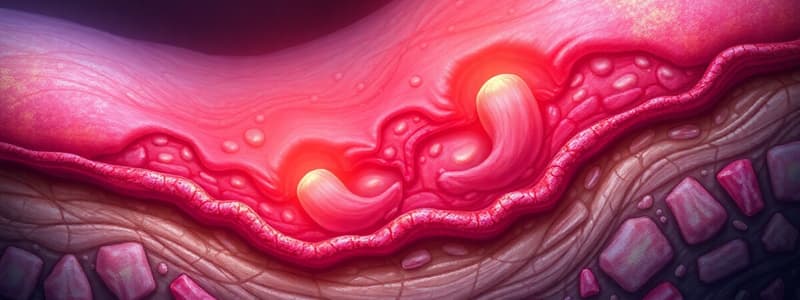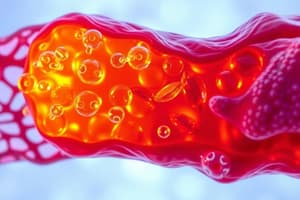Podcast
Questions and Answers
What is the definition of tissue repair?
What is the definition of tissue repair?
- The process of removing damaged tissue and replacing it with scar tissue.
- The replacement of damaged tissue with new, healthy tissue.
- The formation of a new blood clot to stop bleeding.
- The restoration of tissue architecture and function after tissue injury. (correct)
Which type of tissue repair involves the proliferation of existing cells?
Which type of tissue repair involves the proliferation of existing cells?
- Scarring
- Regeneration (correct)
- Organization
- Fibrosis
What is the difference between scarring and fibrosis?
What is the difference between scarring and fibrosis?
- Scarring is a normal process, while fibrosis is always a pathological condition.
- Scarring is a type of fibrosis, but not all fibrosis is scarring.
- Scarring occurs in response to injury, while fibrosis occurs in response to inflammation.
- Scarring is a general term, while fibrosis refers specifically to the deposition of collagen. (correct)
What are the three groups of tissue types based on their proliferative capacity?
What are the three groups of tissue types based on their proliferative capacity?
What are the critical factors that influence regeneration?
What are the critical factors that influence regeneration?
Which type of tissue has the highest regenerative capacity?
Which type of tissue has the highest regenerative capacity?
What is the primary source of growth factors involved in tissue repair?
What is the primary source of growth factors involved in tissue repair?
What is the function of tissue stem cells in repair?
What is the function of tissue stem cells in repair?
What is the primary characteristic of scar tissue compared to regenerated tissue?
What is the primary characteristic of scar tissue compared to regenerated tissue?
Which step is NOT involved in the process of scar formation?
Which step is NOT involved in the process of scar formation?
Which cytokine is considered the most important in the orchestration of connective tissue deposition during scar formation?
Which cytokine is considered the most important in the orchestration of connective tissue deposition during scar formation?
What role do matrix metalloproteinases (MMPs) play in scar formation?
What role do matrix metalloproteinases (MMPs) play in scar formation?
Which of the following accurately describes the outcome of connective tissue remodeling in scar formation?
Which of the following accurately describes the outcome of connective tissue remodeling in scar formation?
Flashcards
Tissue repair
Tissue repair
The process of restoring tissue architecture and function after injury.
Regeneration
Regeneration
Restoration of normal cells by proliferation of existing cells.
Scarring
Scarring
Laying down fibrous tissue to fill a space after injury.
Labile tissues
Labile tissues
Signup and view all the flashcards
Stable tissues
Stable tissues
Signup and view all the flashcards
Permanent tissues
Permanent tissues
Signup and view all the flashcards
Growth factors
Growth factors
Signup and view all the flashcards
Tissue stem cells
Tissue stem cells
Signup and view all the flashcards
Scar formation
Scar formation
Signup and view all the flashcards
Angiogenesis
Angiogenesis
Signup and view all the flashcards
Granulation tissue
Granulation tissue
Signup and view all the flashcards
Remodeling of connective tissue
Remodeling of connective tissue
Signup and view all the flashcards
Matrix metalloproteinases (MMPs)
Matrix metalloproteinases (MMPs)
Signup and view all the flashcards
Study Notes
Tissue Repair
- Tissue repair, also known as healing, is the restoration of tissue architecture and function after injury.
- It involves two main types: regeneration and scarring.
- Regeneration: Restores normal cells by returning components to their normal state through the proliferation of residual cells.
Types of Tissue Repair
- Regeneration:
- Restores normal cells.
- Cells with the capacity to proliferate.
- Scarring:
- Deposition of connective tissue.
- Occurs when tissue is severely damaged, if cells can proliferate.
- Cells without capacity to proliferate.
Regeneration
- Components return to a normal state.
- Occurs by the proliferation of residual cells.
Connective Tissue Deposition (Scar Formation)
- Laying down of fibrous tissue, often resulting in a scar.
- Occurs when tissues aren't able to fully repair themselves.
- Fibrosis (extensive collagen deposition) is a consequence of chronic inflammation (e.g., in the lungs, liver, or kidneys).
- Organisation involves fibrosis in a tissue space containing inflammatory exudate.
Cell & Tissue Regeneration
- Cell proliferation is crucial.
- Growth factors are important.
- Regeneration relies on the integrity of the extracellular matrix (ECM).
- Development of mature cells from stem cells supports regeneration.
- Intrinsic proliferative capacity in cells influences regeneration rates.
3 Groups of Tissue Types
- Labile tissues: Continuously dividing (e.g., hematopoietic cells, surface epithelia). Easily regenerate after injury.
- Stable tissues: Quiescent (e.g., cells in solid organs like the liver). Proliferate only in response to injury or loss.
- Permanent tissues: Terminally differentiated (e.g., neurons, cardiac muscle). Injury is irreversible, leading to scar formation.
Signals of Cell Proliferation: Growth Factors
- Multiple cell types produce growth factors selectively near the site of damage.
- Main sources are macrophages, epithelial, and stromal cells.
- Signaling pathways direct the cell cycle by controlling proteins and checkpoints.
Tissue Stem Cells
- Supplement proliferation of residual cells in specialized niches.
- Triggered by injury and differentiate into mature cells to repopulate injured tissue.
Repair by Connective Tissue Deposition (Scar Formation)
- "Patches" the tissue rather than restoring the original structure.
- Occurs when regeneration is not possible on its own.
- Tissues with severe or chronic injuries or involving non-dividing cells often result in scar formation.
Steps in Scar Formation: Angiogenesis
- Formation of new blood vessels for nutrient and oxygen supply to support repair.
- Formation of granulation tissue: pink, soft, with a granular texture.
- Migration and proliferation of fibroblasts.
- Deposition of loose connective tissue with vessels and leukocytes.
- Remodeling of connective tissue into a stable fibrous scar.
Deposition of Connective Tissue
- Two steps: migration and proliferation of fibroblasts into the injured site; deposition by these cells of ECM proteins.
- Orchestrated by cytokines and growth factors (e.g., TGF-β, PDGF, FGF-2).
Healing by First Intention
- Repair mechanism involving only the epithelial layer.
- Stages: clot formation, neutrophil/macrophage activity, granulation tissue and collagen deposition, reduced inflammation/edema, and final scar formation.
Healing by Second Intention
- Repair mechanism for extensive tissue loss, such as in deep wounds, abscesses, or ulcers.
- Larger fibrin clot and inflammation. Significant granulation tissue formation, collagen scaffolding, and wound contraction is involved.
Fibrosis in Parenchymal Organs
- Excessive deposition of collagen and ECM components in internal organs during chronic diseases.
- Similar to regular scar formation.
- Associated with chronic infections, and immunologic reactions resulting in tissue loss.
- Leads to substantial organ dysfunction, and potentially, organ failure
Abnormalities in Tissue Repair
- Inadequate formation of granulation tissue:
- Wound dehiscence
- Ulcers
- Excessive formation of repair components:
- Hypertrophic scars
- Keloids.
- Exuberant granulation tissue (overgrowth).
- Contractures (tissue shortening).
Selected Clinical Examples of Tissue Repair and Fibrosis
- Healing of skin wounds (primary/secondary intention).
- Fibrosis in injured parenchymal organs.
Factors Influencing Tissue Repair
- Infection, diabetes, poor nutrition, glucocorticoids, renal failure, blood disorders.
- Poor perfusion, foreign bodies, and type of tissue injury.
- Location, and mechanical factors as well.
Healing of Skin Wounds
- First intention (primary union): Small wounds, rapid healing
- Second intention (secondary union): Extensive wounds, longer healing time
References
- Kumar, V., Abbas, A.K., & Aster, J.C. (2019). Robbins and Cotran pathologic basis of disease (10th ed.). Elsevier/Saunders.
Studying That Suits You
Use AI to generate personalized quizzes and flashcards to suit your learning preferences.



